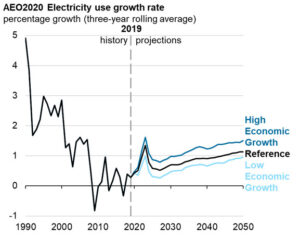Impact of Data on Challenges Facing the Electric Utility Industry
Electric Utilities are facing challenges that are resulting in decreased energy sales and increasing costs. The U.S. Energy Information Administration (EIA) reports a 7% decline in per capita energy sales over the last decade. EIA also “forecasts 5.7% less electricity consumption in the United States in 2020”, and “forecasts that renewable energy will be the fastest-growing source of electricity generation in 2020”. As renewable energy costs are reducing, the cost of electricity for consumers form utilities is increasing. Over the last decade utility investment in new capital to replace aging equipment is also rising. A key contributor to the decline in energy sales is due to customer choices for energy efficiency and self generation.

Graph from U.S. Energy Information Administration
Meeting these challenges requires solutions that use the increased capital investment for new systems that are agile and cost effective in dynamic markets and technologies. What would seem to be a new layer of challenges is also an opportunity to reverse the trends in revenue and cost. Some of these opportunities are:
- Smart Grid Optimization
- Algorithms for minimizing power loss and self-healing grids
- Improved utilization of Distributed Energy Resources through use of the optimization techniques and dual flow networks
- Predictive maintenance – fix it before it breaks or breaks something else
Each of these opportunities requires real time, or near real time data that is useful and actionable. This begins with data quality and interoperability. The data that defines the network that is being optimized must be the same network that is delivering and measuring energy.
Utilities will benefit from more information about customer expectations and likely choices. Are they candidates for self-generation and a potential Distributed Energy Resource? Do they behave like ants, bees, or fireflies?
What are the barriers to collecting and processing the data to become useful and actionable? Much of the emphasis is put on Big Data, Extreme Data, and of course, Extremely Big Data. These technical solutions only address one aspect of the solution. The data becomes useful and actionable when each component of the Utilities’ infrastructure can communicate on a near real time basis using a lingua franca. A common language can be found with standards such as IEC 61968, IEC-61970 (collectively the Common Information Model or CIM), and IEC 61850. A unified model that helps in the convergence of IT and OT.
A key contributor to efficiency and cost reduction is the capabilities of an increasing smarter Smart Grid. The Internet of Things (IoT) allows edge devices to be more proactive and decentralized network can evolve. The decentralized and smarter power grid architecture become the Energy Cloud.
The impact of data to address the challenges of the Electric Utility Industry become a new set of challenges that can be opportunities. The data must be useful and actionable. This requires that the data is reliable, accessible and well understood from edge devices all the way to the back-office, and to customers and all other stakeholders. This can be accomplished using a common language, accessible in the Energy Cloud.
Back To Blog




